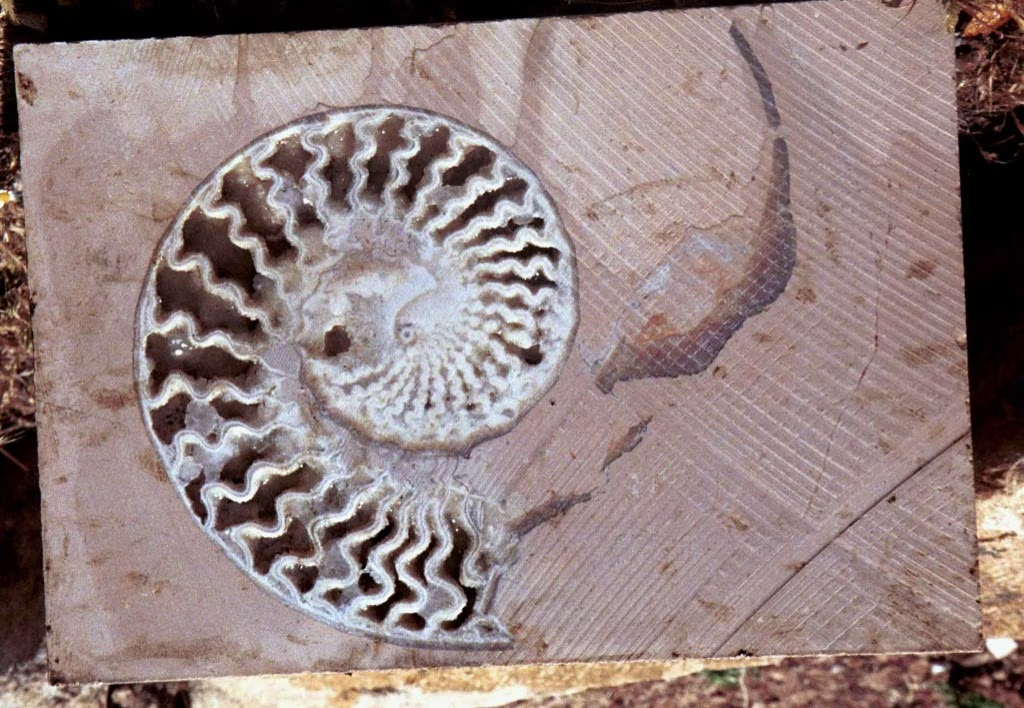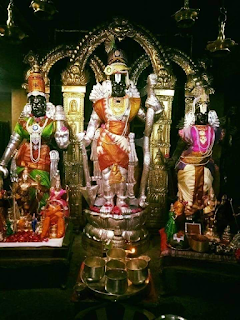With the exception of some households, there are no Hindu houses in India that do not keep the Shaligram Stones reverentially in the puja / prayer room. Particularly, it is true of Brahmin communities across the country; more so in the case of Vaishnavas. In some Hindu rituals these stones are being used for the simple belief that Salagrama stones bring good luck, prosperity, good health and blessings to those who worship them with true devotion. Though it is also used in the talisman to ward off black magic, spells, negative energies, etc., as of today, I have never seen or met men or children wearing the Saligram talisman. Yet another belief has been that daily worshiping of Shaligram - a non-anthropomorphic representation of God Vishnu will get rid of past sins committed in the early birth of the worshipers and in the present birth will help them attain salvation - free from the cycles of birth and death. These beliefs are just purely a subjective matter relied more on assumption than facts or proof. Here, the driving force is trust alone.
 |
| Cross section Salagrama stone with whorls, news.abplive.com |
 | ||
| Salagrama stone (fossil ammonite. arunachalheart.blogspot.in |
Considered a symbol of divinity associated with Sri Vishnu in ancient times, it was a tradition to use shaligrams in the construction of Hindu temples and in the the foundation work. Apart, Saligrama stones may be in the shape of a deity would be placed near the entrance or at certain places in the temple primarily as a mark of divinity or veneration. They may be carved into intricate sculptures of deities and used them as embellishments on temple walls.
Widely revered by the Vaishnavites, these stones are found mostly in the early Paleozoic formations of Devonian to early Cretaceous age in the river beds in the remote foothills of the Himalayas in the Kali Gandaki River Valley of Mustang District of Nepal. Outcrops in the bed lie at 16,400 feet above MSL.
 |
| Cross section of a fossilized shell. peapix.com |
Salagrama stones in reality, are typically fossils of ammonite shells (under the group of Mollusca) from the Devonian upper Paleozoic- Cretaceous (late Mesozoic period), 400 to 66 million years ago. Ammonites are the common name given to the subclass Ammonoidea, an extinct order of cephalopod. The first occurrence of ammonites is from the Devonian around 400 million years ago. They were found in large numbers in the ancient ocean called Tethys that existed in the place where the Himalayas stand now and extended farther westward up to the Mediterranean sea. Upon death Ammonites sank to the bottom sediments that had accumulated over a long period of time in the Continental Shelf and became fossilized after decomposition of the organic matter. The formations with fossils were overlain by sediments and fossils of later geologic periods. The outer protective shells of Ammonites carry whorles and when fossilized the volition or spirals look like a chakra - disc like - the disc of Sri Vishnu. Hence divinity is imparted on them.
But to a geologist, the ''saligrama stone' is nothing but a fossilized specimen found in the sedimentary (or very low-grade metasedimentary) rocks. They are often found in dark- greyish color with visible preservation of the ''whorls''
The idols of Vishnu in the Padmanabhaswamy Temple of Thiruvananthapuram, Badrinath Temple of Garhwal region, Sri Krishna of Udupi are also believed to be made from Salagrama shilas. None of us know that the Moolavar idols in the Ramar temple near Thanjavur, Tamil Nadu built by the Marathas of Tanjore are made of salagrama stones - first of its kind in India.
01. Padmanabhaswamy Temple, Thiruvananthapuram, Kerala:
 |
| Padmanabha Swamy Temple,TV Puram, Kerala.hinduscriptures.com |
The famous and the richest temple in the world Padmanabha Swamy Temple in East Fort in Thiruvananthapuram district has a huge idol of God Vishnu in the garbhagriha - Sree Kovil. He is enshrined here in in the Ananthashayanam posture lying on the coiled bed of Adishesha. The 18 ft long idol is made up of 10,008 Saligramam stones well plastered with Kadusharkara Yogam which is a mixture of ayurvedic herbs - 108 natural materials collected from all over India and forms a coat-like protection that keeps the deity clean. The daily worship is with flowers, and for the abhishekam, Utsava murthy or processional idols are used. No abhisheka on the man idol. The stones were transported (1731 CE) from the Gandaki River Valley and were used in the reconsecration of Lord Padmanabha.
Legend has it once the lord in the guise of a naughty boy swallowed the Saligrama (a kind of stone revered by the Hindus) that was worshiped by sage Divakara. After some mischief, Lord revealed his form in reclining Anantha Sayanam posture and asked the sage to worship him in three forms - first as Shiva, second as Lord Brahma and the third as feet of Lord Vishnu - total surrender to him means ultimately one will get salvation - free from the cycle of birth and death.
https://www.navrangindia.in/2016/04/the-interesting-legend-of-padmanabha.html
ooo
02. Sri Ramar temple, Thanjavur at Mariamman kovil, TN:
 |
| Kothandaramar kovil, Mariamman kovil, idols. tamilbrahmins.com |
https://www.navrangindia.in/2014/12/largest-shaligrama-fossilized-rock.html
ooo
03. Sri Krishna temple, Udupi, Karnataka:
 |
| Salagrama idol of Shri Krishna Udipi. KA udupishiroormutt.in |
Sri Krishna temple, Udupi, Karnataka is a popular one founded by the Vaishnavite Saint Sri Madhwacharya, Udupi Sri Krishna temple was built in the 13th century and the idol was installed by Sri Madhvacharya himself on the Makara Sankranti day. The seer found the idol of Sri Krishna in a large lump of gopichandana (yellow clay used by Vaishnavites to wear their religious mark on their forehead, etc; in Tamil it is commonly called Namam or Thirumun. It is usually believed that Lord Krishna himself created a deity from a Shila – grama with the support of Vishwakarma. The deity was worshiped 14 times in a day by Sri Madhvacharya.
https://www.templedairy.in/sri-krishna-temple-udupi
00
04. Badrinath Temple, Uttarakhand:
 |
| Badrinath templesupload.wikimedia.org |
First established by Adi Shankaracharya legend has it that he found a black stone image of Lord Badrinarayan made of Shaligram stone in the Garhwal hill tracks in Chamoli district along the banks of Alaknanda River in Uttarakhand. One of the 108 Divya Desams dedicated to Vishnu it is open for six months every year (between the end of April and the beginning of November), because of extreme weather conditions in the Himalayan region.The great Acharya initially enshrined the holy object in a cave near the Tapt Kund hot spring. One of the four prime pilgrimage centers for the Hindus, Badrinath, the aspiration of every Hindu is to visit Badrinath, Kedarnath temples in the Himalayas, then Vishwanath temple,Varanasi UP and Ramanatha temple in Rameswaram, TN. The main idol in the innermost sanctuary is one meter tall and is made of Shaligram (black stone).
ooo
05. Puri Jagannath temple:
 |
| Jagannath temple of Puriexoticindiaart.com/ |
 |
| Salagrama stone, Puri jagannath temple, Puri, Odsha.digiteye.in |
One of the famous Vishnu temples on the east coast of India is that of Jagannath temple in the coastal town of Puri, Odisha. Here, the deities in the sanctum are Jagannath, Balabhadra and sister Subhadra made of neem wood. Legend has it that the king of Nepal presented shaligrams to the king of Odisha, Jajati Keshari in the 11th century. Since then shaligrams have been placed at the heart of successive wooden idols of Jagannath. The wooden idols are changed periodically every 12 to 15 years. In the recent past the king of Nepal Gyanendra offered three shaligrams to the deities. His previous visit was in 2003.
'A video was going viral on social media claiming that “The Narsimha Shaligram of Puri Jagannath is removed in the difficult times and last time it was removed during the time of Spanish Flu in 1902” to ward off the ill effects of the disease. (actually, Spanish Flu took place in 1918, not 1902). Again it was taken out during the COVI-19 pandemic.'' Many devotees question the veracity of the viral video and considered it a hoax..........................
ooo
06. Kurudumale Ganesha Temple, Kolar District, KA
 |
| kurudumale-ganesha-temple.business.site |
Located at a distance of just 10 kilometres from Mulbagal town, Kurudumale Ganesha Temple, in the Kolar district of Karnatak close to the Tamil nadu border is a popular one. Surprisingly, it has a big idol of God Ganesha 14 ft tall made out of Salagrama stone. It is at the foot hills and legend has it it was installed by the trinity gods Shiva, Vishnu and Brahma after God ganapati had slain a demonic Asura - Tripurasura. It is said this placed was visited by Pandava brothers and also Rama on his way to Lanka to bring back his consort Sita.Chola and later Vijayanagara rulers patronized this temple, according to temple inscriptions.
It is said people taking up new jobs and politicians before hitting the campaign trails never fail to get the blessings of God Ganesha to be successful in their chosen profession.
ooo
07. Oppiliappan Kovil near Kumbakonam, TN:
 |
| Oppiliappan temple, near Kumbakonam, TN en.wikipedia.org |
Counted as the 60th of the 108 Divya Desams dedicated to Vishnu also known as Oppiliappan, here the lord's consort is Lakshmi as Bhudevi. It is near Thirunageswaram which is close to the temple town of Kumbakonam. The Medieval Cholas of the late 8th century CE, and the Thanjavur Nayaks of later period made considerable contributions at different times. The idol of Sri Vishnu in the sanctum is a huge one. An interesting feature of him is he is wearing a huge Salagrama Mala (garland reaching his holy pathams) consisting of 1008 salagrama stones according to to the Bhattacharyas -pundits who take care of Nithya pujas at the temple.
https://www.rudraksha-ratna.com/buy/jagannath-puri-shaligram-murti
https://digiteye.in/saligram-stone-at-jagannath-temple-has-not-been-taken-out-fact-check
ooo
08. Ayodhya Ram Temple,UP:
 |
| Ayodhya Ram temple, UP Shaligram stone sNDTV |
Two huge blocks of Salagrama rocks one weighing 26 tonnes and the other 14 tonnes were brought to Ayodhya Ram Temple site, Uttar Pradesh from Nepal's Mustang district ( covering nearly 500 kilometres over eight days) in the first week of Feb. 2023. From the big blocks of holy rocks the idols of Lord Ram and Sita will be carved out to be enshrined in the garbhagriha (sanctum/ Sree Kovil) of the new Ram temple. The rock masses were presented to the Shri Ram Janambhoomi Teerth Kshetra Trust after special prayers. Devotees in large numbers made beelines to take a good look at the rocks from which idols would be made.
ooo









